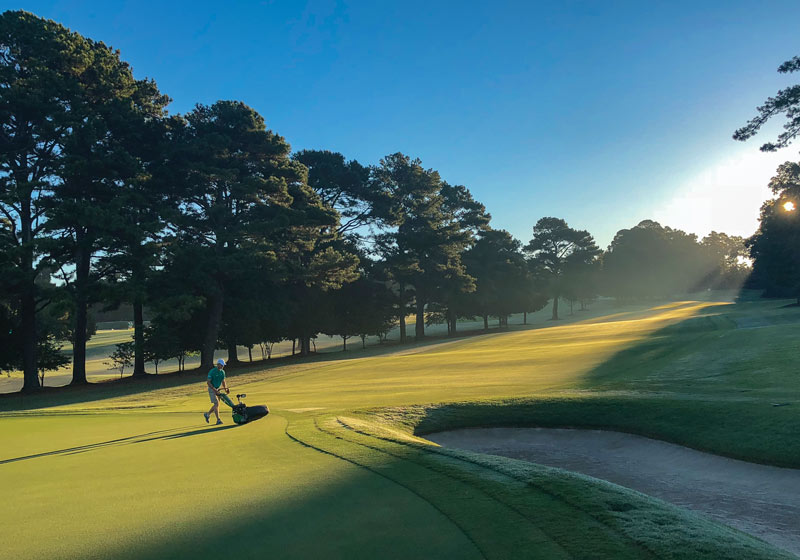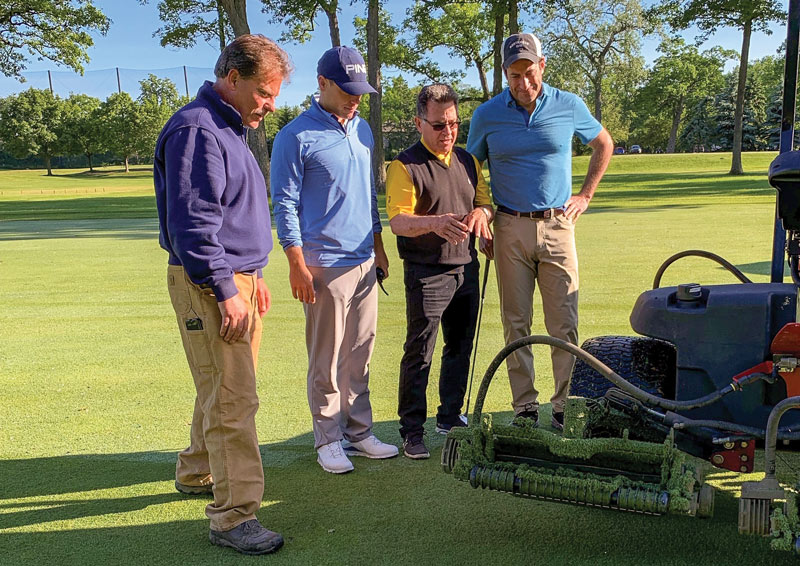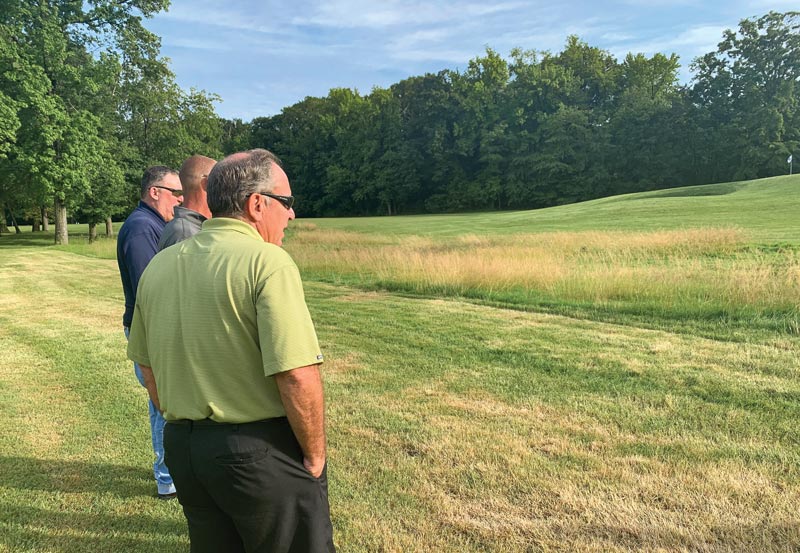
A healthy working relationship between superintendent and green committee is an asset to a golf facility. GCM staff photo
The green committee is arguably the most important committee at the private club level, as it advises on the golf course maintenance and playing conditions standards and the upkeep of the club’s greatest, most important and most valuable asset: the golf course.
After more than half a century in the industry, including more than two decades as a consultant, I have found there are several nearly universal truths regarding the formation and operation of the green committee and its relationship with the golf course superintendent. Not every suggestion will work at every facility, but the recommendations below are tried-and-true guidelines that should contribute greatly to efficiency and harmony among all involved parties, and, most importantly, help ensure the highest mutually agreed-upon standards of maintenance for the golf course.
Setting the standard
The superintendent should prepare the golf course maintenance and playing conditions standards document that is presented to the green chair and committee for their comments and approval. The superintendent then carries out this direction from the green committee without its oversight. The superintendent is held accountable for carrying out the green committee’s policies, goals, priorities, objectives and procedures.
Directions from the green committee should be in writing so there is no confusion surrounding what is and what is not desired in the playing conditions standards. The green committee and superintendent should together prepare a mission statement that explains all aspects of the goals and objectives that they will collectively follow. (The word “green” in the “green committee” name is always singular, as the wording expresses the entire growing area of the course and practice areas, not just the greens.)
The green committee should stand alone. It should not be a subcommittee of the golf committee or any other. The green chair should be in an advisory position at the club — sometimes also in a supervisory position, depending on the club’s overall operation. The green chair’s responsibilities are important, and this person should be willing and committed to active participation, especially because this is a volunteer position. Personal agendas should be avoided, as considered decisions are vital for long-term success.
A green committee chair should have a thick skin and an open mind, be even-keeled and patient, and have a sense of humor. Tough decisions should be made as they arise, even though sometimes they may not be popular.
The green chair should be the direct link to work with the superintendent, and the two must be transparent with each other. The superintendent should also have a good working relationship with the general manager in day-to-day operations (for example, human resources, accounting, health insurance, department head meetings, working with other departments, etc.).
Green committee makeup considerations
To ensure that decisions benefit the majority of the golfing membership, green committee members should be even-tempered, well respected and representative of varying golfing abilities and age groups, and they should also play often. Ideally, the committee would include a low-handicap golfer and a middle-handicap golfer chosen from men, women and senior golfers.
Green committee members should devote enough time to participate fully, and they should complete their full tenure. They are volunteers, but they must be committed to devoting the proper amount of time. They should not be “armchair superintendents,” which are becoming more common because of the vast agronomic information available on the internet.
Committee candidates should understand that playing conditions are affected and dictated by the weather conditions on a day-to-day basis. They should be approachable and have the ability to communicate reasonable concerns of the membership to the chair and committee, and be able to communicate news and updates from the committee back to the membership. They should filter what is recommended for reasonable change. Ideally, they should be willing to be reappointed to the green committee if desired by the green chair and club president. They should be encouraged to read the USGA’s Glossary of Golf Turfgrass Terms as an indoctrination, so they understand the agronomy practices being discussed.

Tommy Witt, CGCS, (third from left) shares information with his superintendent, golf professional and executive board member regarding the factors involved in the decision to lease vs. purchase equipment. Witt, a past president of GCSAA, is the director of golf course operations at Northmoor Country Club in Highland Park, Ill. Photo courtesy of Tommy Witt
The green chair should be a strong person who is not afraid to stand up to members who have unreasonable demands, but who still represents reasonable desires of the membership. The green chair should take over the responsibility of dealing with member complaints and golfers directly, addressing situations in a direct and timely manner, and taking a strong but fair stand for the programs in place, determining what is an immediate priority and what is not. Having a good sense of humor generally benefits a green committee chair.
Meeting of the minds
The superintendent should prepare the monthly meeting agenda and present it to the green chair for approval. Green committee meetings should be held once a month on a year-round basis, and, if possible and practical, usually on the same day of each month for continuity (for example, the third Thursday of every month).
When the golfing is typically “seasonal,” there are times when the green committee may not formally meet until the season resumes. But there are times when communication — via emails, conference calls, Skype calls, etc. — may be required if a significant decision needs to be made.
The superintendent usually takes the minutes of each meeting and distributes them to the committee. Minutes are crucial, as they provide a written record of actions the committee has taken. Distributing past green committee minutes to new committee members can help educate them so they are better prepared to make contributions.
The green committee and golf committee should have one combined meeting annually to implement the aerification schedule, first and foremost, and then the members tournament and event schedules.
The superintendent should play golf regularly and consistently with different groups of members, committee members and directors. The superintendent should listen intently to what the members in each group have to say and answer any questions or comments as they arise. The superintendent playing golf with the membership offers a direct link to the superintendent without any staff answering questions on their behalf. This also provides an additional opportunity — outside of the superintendent’s daily rounds — for the superintendent to see how the course is playing on a regular basis.
Getting the word out
When time permits, a superintendent should communicate with membership by way of a blog, email newsletter, monthly column on the website, etc., all of which are great opportunities to interact with members in a question-and-answer format. Posting the newsletters along with color photos on locker room bulletin boards and in the golf shop really helps spread the word.
The green committee should balance how golf course and practice facilities should look and how they should be played. Most clubs want the course balanced to play well 50% of the time and look good the remaining 50%. Some tournament-caliber golf courses favor play — a 60/40 or even 70/30 split.
Also, green committee meetings should not last too long. A reasonable time limit of one hour should be set, and each meeting should end as planned. This will cut down on discussions about irrelevant topics so the agenda can be followed and acted upon quickly. The committee and superintendent can tour the course before or after the meeting as necessary and appropriate. Alcohol should not be served at the meetings.
Dealing with great expectations
The green committee should be small — either five or seven members, not counting the superintendent, pro, general manager and golf committee chair. Anything larger is counterproductive. Having an odd number of committee members is vital so that no vote can end in a tie. The immediate past green chair should be an ex officio member of the green committee for one year, for continuity.

Green committee members inspect no-mow fescue areas at Sparrows Point Country Club in Baltimore. A green committee being familiar with the golf course is crucial to ensure harmony and productivity with the course’s maintenance team. Photo courtesy of Tyler Bloom
The green committee should manage member expectations properly and efficiently, especially expectations that stem from watching televised golf tournaments and playing other golf courses. Members should be educated about the resources, budgetary restraints and other factors the committee and superintendent have to deal with. They also need to be made aware that greater resources and additional volunteer staff are being used for TV tournaments — factors that are hard to duplicate for everyday play. Copying what other local or regional clubs are doing well might not work at other clubs, as each course should stand on its own merits and circumstances (for example, different soil types, irrigation water quality, course design, maintenance budgets, staffing, etc.).
Generally, the superintendent is the best in-house expert to explain what the goals and objectives are and what the budget will allow. The club should give the superintendent the proper tools, materials and staff to do the job properly.
The green committee, along with the superintendent, should develop a communication plan that keeps the board of directors and entire membership informed in advance of planned maintenance programs and activities. The plan, whether delivered electronically or via printed newsletters, should include regular updates on maintenance schedules and current course conditions. The updates should always be educational and factual regarding various procedures — greens, tees and fairway aerification; when play will be interrupted — without getting too in-depth regarding agronomic practices.
Communicating to the membership through the annual meeting and through annual reports from the green chair and superintendent are other great ways to keep everyone informed.
Green committee responsibility and authority
The green committee is responsible for approving the golf course maintenance operating budget, the equipment replacement and additional equipment requirements budget, and the capital improvement budget, which is prepared by the superintendent and submitted to the green committee for approval and then submitted to the board of directors for approval. There should be contingencies for unforeseen expenses.
At least one of the monthly green committee meetings should be held at the golf maintenance building annually so the green committee members can see the overall operation — how the employees are treated; the golf maintenance equipment and storage area; mechanic’s shop and parts storage; fertilizer and pesticide storage area; chemical mix, load and rinse aid; fuel island; equipment wash rack; soil/material storage area; turf student housing; turf nurseries; etc. As an alternative, each new committee member could be given a tour of the golf maintenance building complex at the start of their tenure.
Because the superintendent has the responsibility, he or she should also have the authority to close the golf course at any time because of adverse weather or turf conditions. This includes the authority to prohibit golf cart usage or require cart paths only, when conditions warrant. These decisions should be honest, fair and forthright.
Maintenance days
Having a weekly time when there are no golfers present during a course closure will allow the golf maintenance team uninterrupted access to perform specialty tasks, such as applying chemicals and fertilizers, verticutting, and topdressing. Options include being closed all day or half a day on a Monday (or other suitable weekday) or on a Tuesday after a Monday holiday, or having tee time gaps of two to three hours, during which the staff can perform tasks around play. When events occur, courses should use shotgun starts at noon or afterward, with no play prior to the event so that maintenance tasks can be performed uninterrupted and to make up for a lost maintenance day.

Author Terry Buchen, CGCS Retired, MG, is a third-generation superintendent/agronomist and the president and consulting agronomist for Golf Agronomy International. Photo courtesy of Terry Buchen
The green committee should seek advice and opinions from the club’s unbiased, independent consulting agronomist, or equal, as necessary and appropriate. Sometimes agronomists’ opinions are not what the green committee wants to hear, but it is in the best short-term and long-term interest of the golf course and practice facilities to hear their opinions. Agronomists often reinforce the opinions and practices of the superintendent and confirm tasks are being performed properly and efficiently.
A long-range golf course architecture committee should be formed for the long-term future, and the club’s golf course architect should advise the club on a regular annual basis of any “tweaking” to the golf course and practice areas that may be required. Most clubs play their newly opened renovated/restored golf course for one full calendar year before any tweaking is made. A long-range master plan and business plan should be prepared by the golf course architect working closely with the superintendent and green chair. Together, they will prioritize the renovation, restoration, repairs and upgrades of the venue’s infrastructure.
Green committee guidelines
• Green chairs/green committee members are not golf course architects. A qualified golf course architect is the resident expert who should receive input from the committee and superintendent, prepare a short- and long-range master plan and business plan of the life expectancy of the infrastructure, and then tweak the plans as required.
• Green chairs should not build monuments to themselves by making personal, ego-driven, poor-judgment design changes to the golf course without consulting with a golf course architect first. The architect and superintendent are experts in the life expectancies of the infrastructure, and they should prioritize and then make recommendations to the green committee.
• Do not micromanage the superintendent and golf course architect. Provide input and let them do the jobs they are qualified to perform.
• The green committee cannot agree on meaningful and correct decisions where the golf course is not maintained to its full potential. Where golf courses fall short of their potential, some qualified superintendents with high career goals and objectives will sometimes seek employment elsewhere.
• The committee should make timely budget requests to the board of directors from a business plan provided by the superintendent and golf course architect for infrastructure renovations, restorations, repairs and upgrades.
• Planting trees to try to change how a golf hole is played without consulting with a golf course architect can come back to haunt a club. Notice how many clubs are removing trees that were planted years before and that are now hindering the growth of quality turfgrass by creating too much shade and restricting air movement — and how the play of affected golf holes is unfavorably altered in the process.
• Not everyone will be happy with the course. The 90% silent majority will be pleased, but the 10% minority (usually low handicappers) will let the club know everything they do not like. A balanced approach to the agronomic and playing conditions standards is the best approach.
• Short tenures can be detrimental to efficiency. High turnover among green committee members wastes time by negating the gains made when committees learn from previous mistakes. It’s a vicious cycle.
• The green chair should attend the annual Golf Industry Show, including attending educational sessions and touring the trade show floor to see firsthand the tools and materials the superintendent should have at their disposal.
• The green chair should be on the board of directors. The chair is typically better equipped than a green committee liaison to communicate effectively with the board.
Green chair tenure
• Establishing a tenure of one year for green committee chairs is a disaster waiting to happen. Annually changing the priorities, goals and objectives is a liability and makes it difficult to maintain a golf course consistently. Few successful clubs, if any, use this approach.
• Ideally, the green committee chair will serve two consecutive terms of three years each. This ensures continuity and a consistently operated green committee.
• If the green chair is deemed — by members as well as by the superintendent — to have served well, there should be a clause in the club’s bylaws that allows the person to serve more than two consecutive terms.
• A co-chair in the last full year of the green chair’s tenure can help ensure a smooth transition.
• The superintendent should be directly involved in the selection of each new green chair. No one knows the golf course better than the superintendent.
• Some of the best green chairs I have seen over the years are dictators — good dictators, for sure — and the most powerful individuals at the club, with long tenures.
For whom does the superintendent work on the private club level?
• At golf and country clubs that use the true general manager concept and the green committee system, the two must work and communicate well together. The GM is the superintendent’s supervisor, and the green committee is an adviser.
• If the club has a GM but the green chair is acting in an advisory and supervisory capacity, this situation can sometimes be difficult for the GM and the superintendent, as they can often be caught in the middle of disputes. The green chair will give direction to the superintendent, who then has to explain to the GM what he has been instructed to do, as the green chair sometimes asks the superintendent to convey the information to the GM.
• At some clubs, the superintendent works directly for the green chair in an advisory and supervisory capacity and also works with the club manager on day-to-day operations.
• Clubs that use the combined GM/director of golf title are frequently clubs operated by management companies. The superintendent usually works for the GM/director of golf in a supervisory capacity and works with the green chair and committee in an advisory capacity.
• When there is one owner of a club, there is no question for whom the superintendent works. There sometimes is a green committee, which acts in an advisory capacity only.
• Superintendents are increasingly becoming GMs. When management companies have the department heads take proficiency tests, the superintendent frequently has the highest scores because of their dedication, knowledge, experience, tenure, college education, business and operational savvy, and work ethic. When the superintendent is the GM, he or she may have a combined GM/superintendent title, bring in a new superintendent and have the GM title only, or promote the assistant superintendent to the superintendent’s title.
• In the business of golf course maintenance, the employer/employee relationship is unique. Green chairs and GMs should depend heavily on the superintendent’s knowledge and experience and lean on the superintendent for agronomic opinions, answers and advice. In agronomic matters, they should not tell the superintendent what to do or when to do it, as they are not agronomists.
Terry Buchen, CGCS Retired, MG, is a third-generation superintendent/agronomist. A 51-year Life Member of GCSAA, Terry has been a Certified Golf Course Superintendent since 1978 and is one of only 80 Master Greenkeepers worldwide.